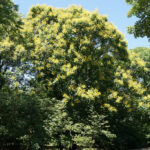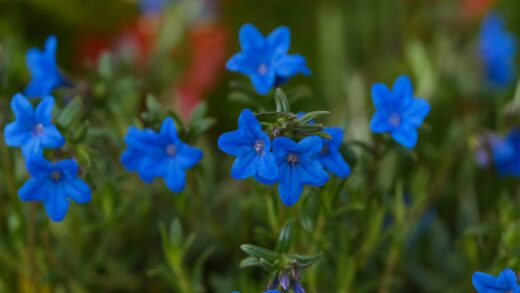Preparing Geranium x cantabrigiense for winter is a refreshingly simple task, as this is an exceptionally hardy and resilient perennial capable of weathering cold temperatures with minimal fuss. One of its most valuable winter attributes is that it is semi-evergreen, meaning that in many climates, it will retain a good portion of its foliage throughout the colder months. This foliage often takes on attractive bronze or reddish hues after the first frosts, providing valuable colour and texture in the otherwise dormant winter garden. This persistent ground cover also serves a practical purpose, acting as a natural mulch that helps to protect the plant’s crown and roots from extreme cold and fluctuating temperatures. The most important prerequisite for successful wintering has already been established long before winter arrives: a healthy, well-established plant in a suitable location. A geranium planted in well-drained soil is far better equipped to handle the challenges of winter than one sitting in cold, waterlogged ground. Excess moisture in the soil during winter is a greater threat than the cold itself, as it can lead to crown and root rot. Therefore, ensuring good drainage from the outset is the single most critical step in preparing this plant for the dormant season. A healthy plant with a strong root system will have the necessary energy reserves to survive the cold and re-emerge vigorously in the spring.
Unlike many other perennials, the Cambridge cranesbill does not require a heavy blanket of mulch for winter protection in most gardening zones where it is hardy. Its own foliage typically provides sufficient insulation for the crown. In fact, applying a thick layer of heavy mulch, like wet leaves or wood chips, directly over the crown can sometimes be detrimental. This can trap too much moisture against the plant, potentially promoting rot, and may also provide a cosy winter home for slugs and other pests. If you live in a particularly harsh climate at the very edge of its hardiness range, a light covering of evergreen boughs can provide some extra protection without trapping excessive moisture.
The primary task for the gardener in autumn is not to add protection, but simply to perform a gentle tidy-up. After the first hard frost, you may notice some of the leaves have turned brown or become mushy. It is perfectly fine to leave the bulk of the foliage in place for winter interest and protection, but you can selectively remove any leaves that look particularly damaged or diseased. A more thorough clean-up is best left until early spring, just before new growth begins to emerge. Leaving the semi-evergreen foliage intact helps to shelter the crown and also catches insulating snow.
For Geranium x cantabrigiense grown in containers, the approach to winter care needs to be slightly different. Plants in pots are more vulnerable to the cold because their roots are exposed to freezing temperatures from all sides, without the insulating effect of the surrounding earth. In colder climates, it is wise to provide some form of protection for container-grown plants. This might involve moving the pot to a more sheltered location, such as against a house wall or into an unheated garage or shed. Alternatively, you can insulate the pot by wrapping it in bubble wrap or burlap, or by sinking the pot into the ground in a vacant part of the garden.
Understanding its hardiness
Geranium x cantabrigiense is renowned for its excellent cold hardiness, a trait inherited from its tough parent species, Geranium dalmaticum and Geranium macrorrhizum. It is reliably hardy in USDA zones 4 through 8, and sometimes even in zone 3 with consistent snow cover. This means it can withstand average minimum winter temperatures ranging from -34°C to -29°C (-30°F to -20°F) at the colder end of its range. This impressive resilience makes it a dependable choice for gardeners in regions with cold winters, where less robust perennials might not survive without extensive protection.
More articles on this topic
The term “semi-evergreen” is key to understanding its winter behaviour. This means that the plant’s response to winter depends heavily on the severity of the local climate. In milder climates, such as those in zone 7 or 8, it will likely retain most of its foliage throughout the winter, which will remain green or take on attractive reddish tints. In colder zones, like 4 or 5, it may die back to the ground completely after prolonged periods of deep freeze, behaving more like a herbaceous perennial. However, even when the top growth dies back, the rhizomatous roots and crown remain dormant and well-protected beneath the soil, ready to send up new growth in the spring.
Snow cover plays a significant role in the winter survival of many perennials, including this one. A reliable blanket of snow is one of the best forms of natural insulation a plant can have. It protects the crown and roots from harsh, drying winds and from the damaging effects of repeated freezing and thawing cycles. In areas where snow cover is inconsistent, a plant might be more vulnerable. This is where the plant’s own persistent foliage becomes particularly important, as it helps to trap any snow that does fall, creating a protective micro-environment.
It is also important to note that a plant’s hardiness is not just about its ability to withstand low temperatures. It is also about its ability to cope with other winter stresses. Well-drained soil is crucial because frozen, waterlogged soil can physically damage roots and crowns. A location that is sheltered from strong, desiccating winter winds can also improve a plant’s chances of coming through the winter in good condition. By understanding all these facets of hardiness, you can site your plant thoughtfully to maximize its natural resilience.
Autumn clean-up and preparation
The autumn preparation for Geranium x cantabrigiense is more about what not to do than what to do. The main principle is to avoid excessive tidying. Unlike some perennials that benefit from being cut back hard in the autumn, it is generally best to leave the foliage of the Cambridge cranesbill in place for the winter. This foliage provides natural insulation for the crown, the most vital part of the plant, protecting it from the cold. A “messy” approach is often the healthiest one for this particular plant.
More articles on this topic
You should, however, perform a light sanitary clean-up. Inspect your plants and remove any leaves that are clearly dead, diseased, or heavily damaged by pests. This helps to reduce the amount of potential disease spores or pest eggs that could overwinter in the garden debris. Simply snip off the individual affected leaves at their base. Do not cut the entire plant back to the ground. The goal is to remove problematic material while leaving the bulk of the healthy, semi-evergreen foliage intact.
This is also a good time to ensure the area around the base of the plant is clear of any accumulated debris that could trap moisture. For example, if a thick layer of fallen leaves from overhead trees has matted down on top of your geraniums, it is a good idea to gently rake them away. A thick, wet mat of leaves can smother the crown and promote rot during the wet winter months. A light, airy layer of its own foliage is beneficial, but a heavy, dense covering from other sources can be harmful.
Finally, as winter approaches, it is important to ensure the plant is not going into the cold season in a state of drought stress. If you have experienced a dry autumn, give your geraniums a final, deep watering before the ground freezes solid. This ensures that the roots and crown are well-hydrated, which helps them to withstand the desiccating effects of cold, dry winter air. A well-hydrated plant is a more cold-tolerant plant. This simple step can make a significant difference in its winter survival and its vigour the following spring.
Winter care for container-grown plants
Plants grown in containers face a much greater challenge during the winter than their counterparts in the garden bed. The soil in a pot can freeze solid much more quickly and deeply because it is exposed to the cold air from all sides. This repeated freezing and thawing can damage the plant’s roots and can even cause porous pots, like terracotta, to crack. Therefore, some form of winter protection is necessary for container-grown Geranium x cantabrigiense, especially in zones 6 and colder.
One of the easiest methods of protection is to move the container to a more sheltered location for the winter. An unheated garage, a cold frame, a garden shed, or a protected porch are all excellent options. The goal is not to keep the plant warm and growing, but simply to buffer it from the harshest temperature extremes and biting winds. The plant should still experience a cold period to go through its natural dormancy. It will require very little water during this time, just enough to prevent the soil from becoming bone-dry, perhaps a light watering once a month.
If you do not have a suitable indoor space, you can insulate the pot itself. Grouping several containers together can help to reduce heat loss. You can also wrap the pots in layers of burlap, bubble wrap, or old blankets to provide an insulating layer. Another effective technique, known as “heeling in,” involves digging a hole in a vacant spot in the garden and sinking the entire pot into the ground up to its rim. The surrounding soil will then provide excellent insulation for the root ball throughout the winter.
Another option is to create a temporary shelter. You can surround the pot with a chicken wire cage and fill the space between the cage and the pot with an insulating material like straw or shredded leaves. This creates a protective barrier against the cold. Regardless of the method you choose, the aim is to protect the vulnerable root system from the rapid and extreme temperature fluctuations that can occur in an exposed container, giving your Geranium x cantabrigiense the best possible chance of surviving the winter in good health.
Spring revival and clean-up
As winter begins to recede and the first signs of spring appear, it is time to help your Geranium x cantabrigiense transition back into its growing season. The main task is a final, more thorough clean-up of the old foliage that was left in place for the winter. The timing for this is important. It is best to wait until the danger of hard frosts has passed but to act before the new growth becomes too advanced. You will see fresh, green shoots beginning to emerge from the crown at the base of the plant.
Using a pair of clean, sharp secateurs or garden shears, carefully cut back and remove all of the old, tattered, and brown winter foliage. Be gentle and precise to avoid accidentally damaging the tender new shoots that are emerging from the crown. This spring “haircut” not only improves the plant’s appearance, making way for the fresh new leaves, but it also improves air circulation around the crown as the plant begins its period of rapid growth. This can help to prevent any potential fungal issues from taking hold.
After cleaning up the old foliage, it is a perfect time to apply a top-dressing of compost. Spread a 2-3 centimetre layer of compost around the base of the plant. This will provide a gentle, slow-release source of nutrients to support the plant’s growth throughout the coming season. The compost also acts as a light mulch, helping to conserve soil moisture as the weather warms up. This simple spring feeding is generally all the nutrition the plant needs for the entire year.
Once the clean-up is complete and the plant has been fed, give the area a good watering if the spring has been dry. This will help to settle the compost and provide moisture to the roots as they become active again. Keep an eye on the emerging new growth. The rapid appearance of lush, green leaves is a sure sign that your Geranium x cantabrigiense has successfully overwintered and is ready to put on another beautiful display in your garden. This simple spring ritual sets the stage for a healthy and floriferous season ahead.


















